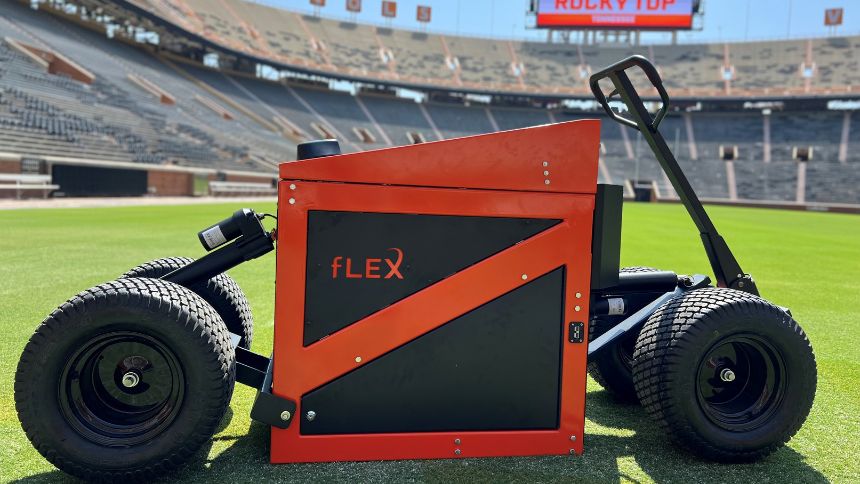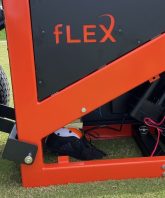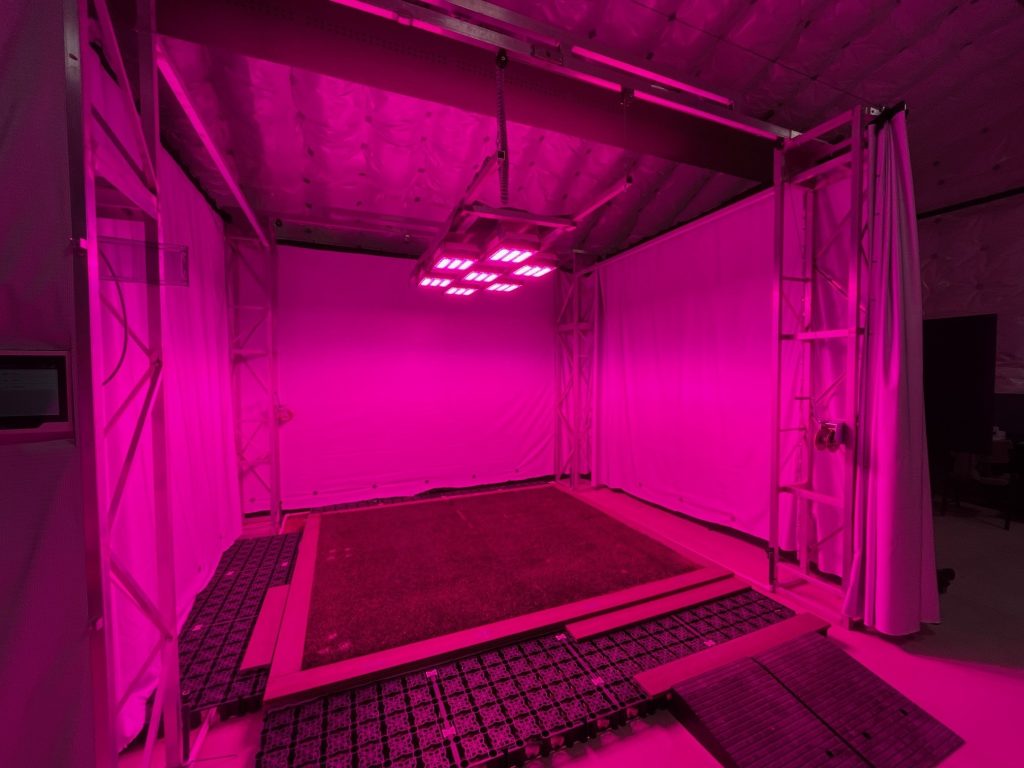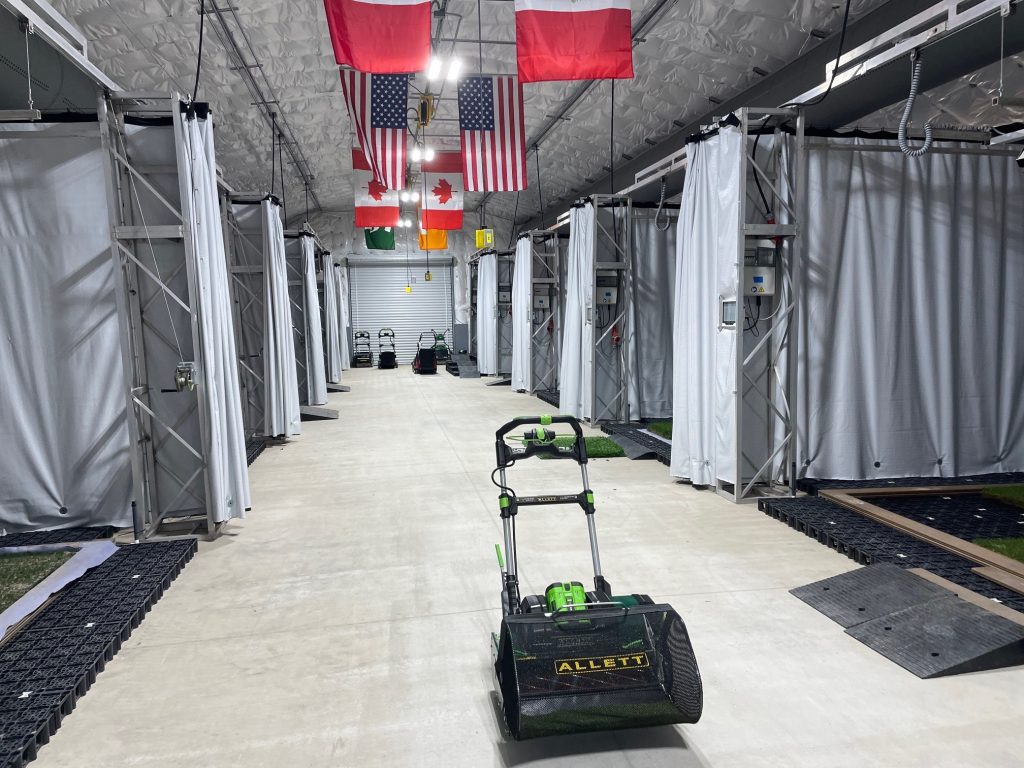
Two UTK researchers are focused on the interaction of turf with safety of athletes
John Sorochan and Kyley Dickson just unveiled version 3 of "The fLEX" machine ahead of Saturday's first Tennessee football game.
When the Tennessee Volunteers run through the Power T shortly after noon on Saturday, the field conditions will have been assessed earlier by a team of turf scientists at the University of Tennessee, Knoxville (UTK).
Later in September, after two Morgan Wallen concerts at Neyland Stadium, the team will again assess the field to ensure that anything that the stage has done to impact the field and affect player safety is known and addressed.
As John Sorochan told us in a 2022 teknovation.biz article, “Fields can change throughout a game and for sure over an entire season.” He’s a Distinguished Professor of Turfgrass Science and Management at the UT Institute of Agriculture. Along with Kyley Dickson, Researcher and Co-Director of the UT Center for Athletic Field Safety, they have developed a device known as “The fLEX” that measures the performance and playability of surfaces such as Shields-Watkins Field.
Their longstanding work – we first spotlighted Sorochan in this July 2014 teknovation.biz article – has drawn worldwide attention, particularly as it relates to the FIFA World Cup 26 that will be played across Canada, Mexico and the U.S. But, while that is an important part of their story, it is more about determination combined with patience and expertise, all coupled with a passion for understanding the impact that turf conditions can have on an athlete’s body.
In February, their work was recognized as one of the recipients of the inaugural “Chancellor’s Innovation Fund,” receiving a $50,000 award to move their technology from the lab toward the marketplace. The new fund, which is administered by the Office of Research, Innovation, and Economic Development (ORIED), is aimed at bolstering East Tennessee’s entrepreneurship pipeline and providing a pathway to commercialize technology for faculty.
Sorochan, a native of Calgary, came to UTK in 2002, and Dickson, who is an East Tennessee native, was one of his graduate students. Last week, Dickson drove to DTS Industries in Annville, KY, where he received delivery of Version 3 of “The fLEX” device. The latest iteration has a great deal of technology and automation, and they believe that it is very close to the final version that will be commercialized.
One day later, we were invited to see the newest version in operation at a site off Alcoa Highway, and it is an upgrade from Version 2 that required a lot of manual adjustments to complete the readings. Now, many of those functions are automated, and the newest version even incorporates the ability to wirelessly transmit data. That allows the end users to review and act more quickly than having to wait until the data is downloaded.

The newest iteration combines what previously would have been five devices into one. Version 1 was developed in 2019, while version 2 came along two years later. And, unlike the earlier, more rudimentary version, the newest iteration even comes with a 3D-printed foot that is fitted with a shoe for soccer – men’s or women’s – and the appropriate cleats.
Bob Vanderhoff, a seasoned business leader who serves as Chief Executive Officer of the start-up named fLEX Standard Solutions, has been working closely with Sorochan and Dickson as they move closer to actually manufacturing fLEX machines.
“We’ve developed a business plan and pitch deck,” he said.
UTRF has several patents pending for the technology in various countries including the U.S., Europe, and Australia, according to Kusum Rathore, Executive Director and Vice President of UTRF’s Multi-Campus Office.
fLEX Standard Solutions will be seeking $1.5 million in funding to move forward on licensing the technology and making the devices.
Sorochan has been a turf scientist for three decades, studying the interaction of field surfaces on players. He has also been working with the National Football League Players Association representing the for field safety and performance for several years.
So, how different are fields? They explain that Shields-Watkins Field and the fields at two other Southeastern Conference institutions – Georgia and South Carolina – have the same grass, but somewhat different surfaces. That’s what makes the fLEX machine and the data it generates so important.
“We are not just telling people their field might performance problems; we are giving them a solution,” Dickson says.
The team at the UT Center for Athletic Field Safety even has an indoor research facility where more than 12 different experiments growing turf can occur at one time.
Like what you've read?
Forward to a friend!



